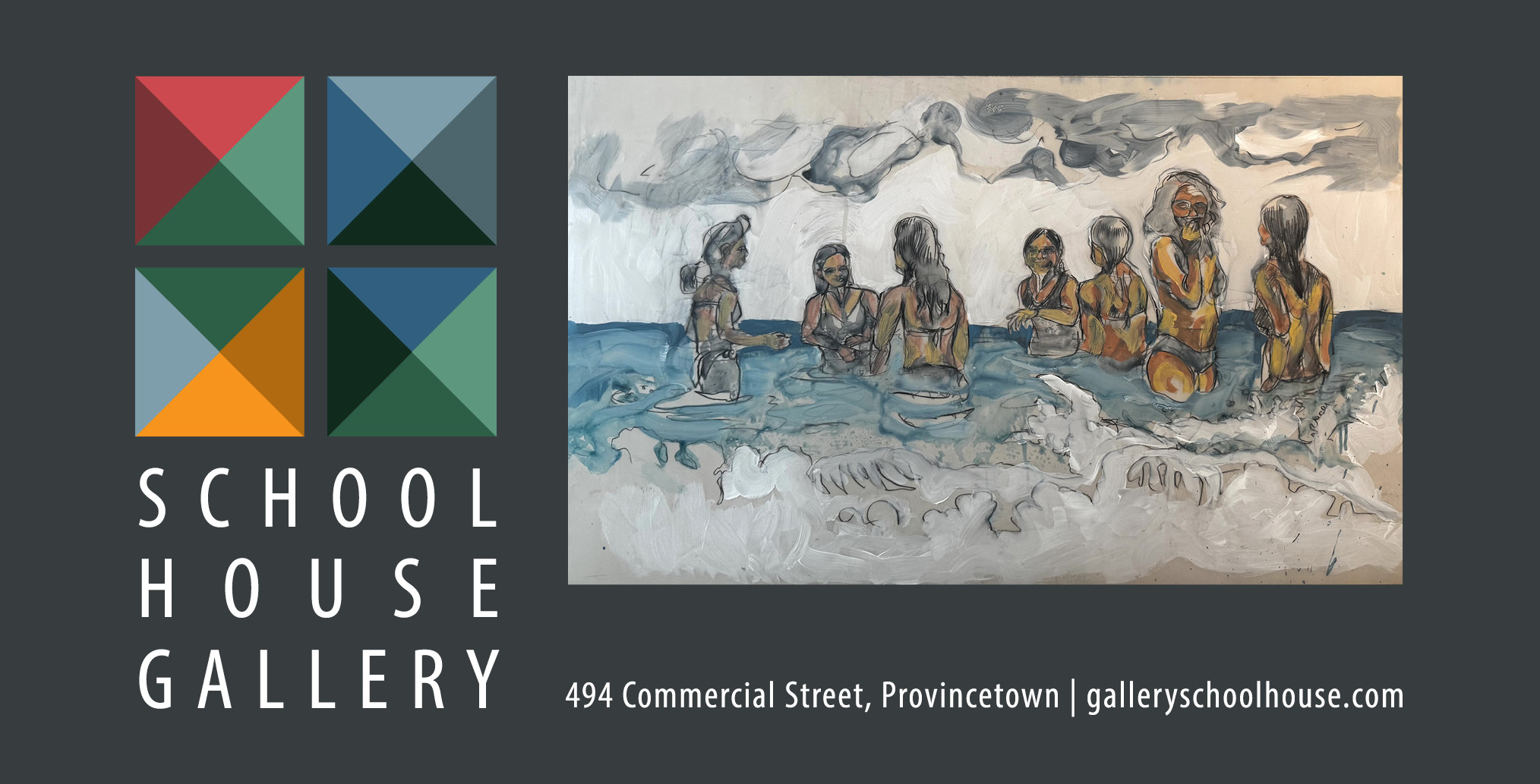Anthony Fisher remembers seeing an exhibition at the Provincetown Art Association and Museum of Alvin Ross’s realist paintings. Fisher was 14 years old. “It was really an inspiration,” he says, although he would develop into a very different kind of painter. Now, 50 years later, the museum is featuring Fisher’s work in a solo exhibition called “ReVisions.”
Fisher, who lives in Newton, grew up in Pittsburgh, Pa. but visited the Outer Cape with his family starting in the early 1970s. In 1981, his family purchased a house in Provincetown, and Fisher has maintained a relationship with the community since.
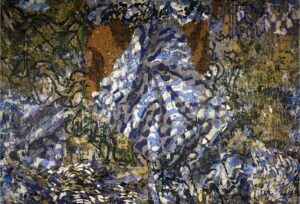
Donald Beal, a Provincetown painter and longtime friend of Fisher, curated “ReVisions,” which is on view through July 20. The pieces in the exhibition encompass a series of black-and-white paintings created through experimental processes and a series of dense oil paintings that read as abstractions yet contain traces of still-life and figurative painting.
A short film that plays in one corner of the exhibition space shows the process behind the black-and-white works. In 2015, while recovering from ankle surgery, Fisher experimented with new methods of making drawings and paintings. In the video, he works in his studio, drawing with a magnet attached to one side of a sheet of paper; when moved, the magnet directs pencils on the other side of the paper to make marks. Fisher also wrapped canvases around tubes and drenched them with paint. After it dried, the canvases were stretched. The final results preserve the material play inherent in their making — gravity and happenstance are the major actors here. “I’m trying to trap accidents all the time,” says Fisher.
In The Bridge to the Exit Is Out, the paint spreads in all directions across the surface of a large canvas — the result of moving it around as it dried — but this image is also the most representational of the black-and-white paintings. It rides the line between accident and intention. Its swooping lines and gridwork forms suggest an urban space. Fisher says the image reminded him of photographs he saw of the container ship that crashed into the Francis Scott Key Bridge in Baltimore last year.
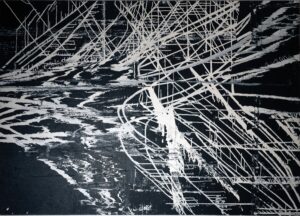
Fisher’s other black-and-white paintings recall oil spills and reflections in water both as images and as byproducts of the process by which they’re made. He says he often thinks about movement, tempests, and roiling water while he’s working. His other paintings, the most recent in the exhibition, are more static on the surface. The paint is caked on and layered, evoking a sustained engagement and struggle with the work, much like the labored, heroic paintings of Rembrandt and Willem de Kooning. Like them, Fisher finds a way to breathe grace, light, and movement into these dense paintings.
“I’m pretty much a formalist,” says Fisher. His paintings are primarily concerned with texture, light, space, rhythm, and surface quality. They are present as visual objects, not as armatures for conceptual ideas. Fischer is also a teacher. As an associate professor of art and design at UMass Dartmouth, he insists on a reciprocal relationship between his teaching and his art. “I always bring my own studio life to my students, and I bring stuff from them to my studio,” says Fisher.
He often teaches students to draw from models and focus on things like the space around the model, the atmosphere, and the articulation of a figure in the paper, not on the paper. There are no people in Fisher’s paintings, but a central figure-like presence often appears. In Shroud for an Uncertain Time and Seeking an Inner Stance, a patterned cloth commands the center. The fabric suggests a still life (perhaps from a classroom assignment), but it also suggests a figure with its gentle, sensuous curves. It’s firmly embedded in the paintings with only a subtle distinction between figure and ground, almost like a weaving.
In Shroud for an Uncertain Time — and many other works in this exhibition — Fisher creates horizontal movement at the bottom of the painting through a pattern of lines that undulate rhythmically across the surface. This element is suggestive of waves or turbulent water from which the shroud arises. It also creates space and places the figurative element deeper within the painting.
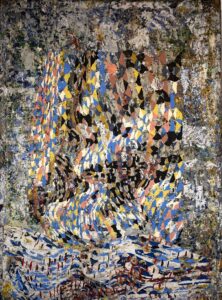
“I love the things that are on the surface, but the concept of space is most important for me,” says Fisher. “To take a flat thing and project space into it is still magic.”
While the spatial elements of Fisher’s paintings take time to unfold as one sits with them, the surface quality of the paintings is immediately evident. He often paints on cardboard that he likens to bulletin boards, which he can keep adding to and taking from. Like the tactile, layered quality of a well-used bulletin board, these paintings reveal the history of their making.
Just as Fisher often avoids using canvas, he also avoids brushes (he cites as an influence arte povera — an art movement that arose in Italy in the 1960s and emphasized the use of simple everyday materials). Consequently, the paint has an intensely physical presence. In Seeking an Inner Stance, a passage of brown paint protrudes from the surface like a shag rug. In other areas, pieces of paint are applied with stencils so that they appear like shapes plastered onto the surface. Fisher also collages photographs into some of his surfaces and often scrapes away layers of paint only to build the surface back up again.
A Way to Get Out of My Way is one of Fisher’s characteristically dense paintings. It’s also an example of how he uses light to temper the bravado of these pictures. The painting is divided on a vertical axis between a dark half and a light half. Stenciled, triangular patterns of white and yellow paint flutter between the two halves like butterflies or delicate notes in a symphony dominated by thunderous passages.
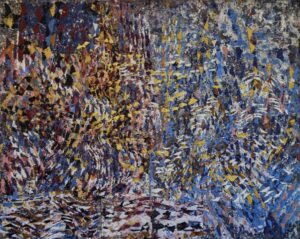
Thicket is perhaps the exhibition’s strongest example of the tension that exists in Fisher’s work between delicacy and heft. Layers of paint have been sanded and rebuilt to create a durable, leathery skin on the canvas. On top of this surface, Fischer has stenciled a tangle of lines with white and light-gray paint that build outward from the center to create a spiraling form.
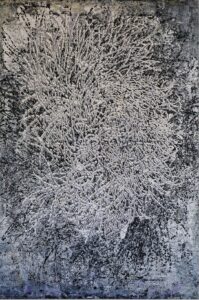
As the title suggests, the form at the center of the painting looks like a thicket, dense with thin, fragile branches. Fisher was thinking about Leonardo da Vinci’s drawings of turbulence in water and air while making this painting. “Leonardo’s drawings are some of my favorite art ever made,” he says. Like those drawings, there’s something both stormy and sensitive in this painting, but the piece also moves in unexpected directions. Turbulence became a thicket. “I was surprised by the result,” says Fisher. “It was different than I expected.”
One of the most prominent links between the two bodies of work in this exhibition is Fisher’s openness to process and surprise. “I wouldn’t be interested if I knew where I was going,” he says.
ReVisions
The event: Exhibition of paintings by Anthony Fisher
The time: Through July 20
The place: Provincetown Art Association and Museum, 460 Commercial St.
The cost: General admission, $15
